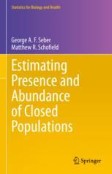Search
Search Results
-
Estimating density of leopard (Panthera pardus fusca) using spatially explicit capture recapture framework in Gir Protected Area, Gujarat, India
Despite their high dietary and behavioural flexibility, leopards have lost > 70% of their historic range due to the causes like habitat loss, prey...

-
Integrating multiple datasets into spatially-explicit capture-recapture models to estimate the abundance of a locally scarce felid
The conservation of animal populations often requires the estimation of population size. Low density and secretive behaviour usually determine scarce...

-
Population density estimate of leopards (Panthera pardus) in north-western Mpumalanga, South Africa, determined using spatially explicit capture–recapture methods
The African leopard ( Panthera pardus pardus ) has lost much of its historical range within South Africa. The remaining suitable habitat for the...

-
Capture-Recapture: Frequentist Methods
Capture–recapture methods for both open and closed populations have developed extensively in recent years, especially with the development of...
-
Evaluating density-weighted connectivity of black bears (Ursus americanus) in Glacier National Park with spatial capture–recapture models
BackgroundImproved understanding of wildlife population connectivity among protected area networks can support effective planning for the persistence...

-
Consequences of ignoring variable and spatially autocorrelated detection probability in spatial capture-recapture
ContextSpatial capture-recapture (SCR) models are increasingly popular for analyzing wildlife monitoring data. SCR can account for spatial...

-
Spatially explicit population estimates of African leopards and spotted hyenas in the Queen Elizabeth Conservation Area of southwestern Uganda
African leopards ( Panthera pardus pardus ) and spotted hyenas ( Crocuta crocuta ) are data deficient across much of Africa, and there are only a handful...

-
Density of wild felids in Sonora, Mexico: a comparison of spatially explicit capture-recapture methods
Estimates of population density are crucial for wild felid conservation and are commonly conducted using camera trap**. Spatially explicit...

-
First spatially-explicit density estimate for a snow leopard population in the Altai Mountains
The snow leopard Panthera uncia is an elusive and globally-threatened apex predator occurring in the mountain ranges of central Asia. As with other...

-
Spatial capture–recapture reveals high densities of large Indian civet, an omnivorous small carnivore in Southeast Asia
Small carnivores (≤ 15 kg) are rich in species, and diverse in ecology and functional roles, yet population estimates are lacking for most species,...

-
Estimating red fox density using non-invasive genetic sampling and spatial capture–recapture modelling
Spatial capture–recapture modelling (SCR) is a powerful tool for estimating density, population size, and space use of elusive animals. Here, we...

-
Precision as a metric for acoustic survey design using occupancy or spatial capture-recapture
Passive acoustic surveys provide a convenient and cost-effective way to monitor animal populations, and methods for conducting and analysing such...

-
An insight into the ecology of the invasive house mouse on small Mediterranean islands
The invasive house mouse Mus musculus represents a great threat to islands. Eradicating house mouse populations is thus often necessary, entailing...

-
More than one way to count a cat: estimation of ocelot population density using frameworks for marked and unmarked species
Camera-traps have become one of the most common tools for studying wildlife abundance and population density. Traditionally, absolute density could...

-
The use of spatially explicit capture-recapture models for estimating Iberian lynx abundance in a newly reintroduced population
From 2015 till 2018, 33 lynxes were released in southeast Portugal (Guadiana valley) as a result of an Iberian reintroduction project. Since then, at...
-
Caterpillar movement mediates spatially local interactions and determines the relationship between population density and contact
BackgroundWhile interactions in nature are inherently local, ecological models often assume homogeneity across space, allowing for generalization...

-
Using density estimates, sex ratios and size structure to assess the status of a threatened Australian freshwater crayfish (Euastacus armatus) population
Managing and conserving wild animal populations relies on accurately describing changes in populations through time. Density estimates, sex ratios...

-
Overview of Hierarchical Models and Future Directions in the Study of Neotropical Mammals
This chapter provides a concise overview of the hierarchical models that are commonly used in the literature and throughout this book. Its purpose is...
-
Estimating the density of small mammals using the selfie trap is an effective camera trap** method
Camera trap** to study wildlife allows for data collection, without the need to capture animals. Traditionally, camera traps have been used to...

-
Estimating density of an elusive carnivore in urban areas: use of spatially explicit capture-recapture models for city-dwelling bobcats
An important first step in managing urban carnivores or the habitat in which they live to reduce risk of conflicts with humans is to understand their...

